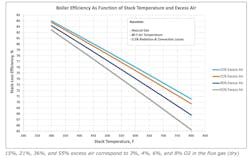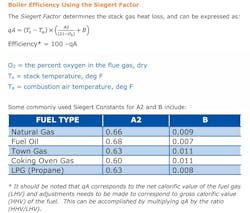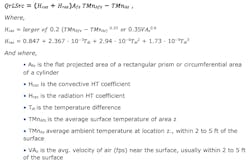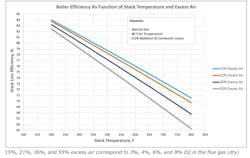Calculating Boiler Efficiency via Stack Loss
By M.W. VALENTINO, R.K. Black, Technical Consultants
In the boiler-burner industry, the term “efficiency” is used by manufacturers, engineers, trade organizations, and governmental agencies to publicize and differentiate the effectiveness of products at converting available energy to produce hot water and steam.
Typically, application of the term efficiency will fall into one of four categories: (1) Combustion Efficiency, (2) Boiler Efficiency, (3) Thermal Efficiency, and (4) Fuel-to-Steam Efficiency.
A basic description of these terms, are:
- Combustion Efficiency is a measurement as to how well a burner converts the energy provided by a fuel into usable heat. However, it should be noted that Combustion Efficiency is often used to mean boiler Stack Loss Efficiency without consideration to Radiation & Convection (R&C) losses from the boiler external surfaces;
- Boiler Efficiency is a general term requiring further definition as to what is intended or included in its meaning. For example, are R&C heat losses from the boiler external surfaces included?
- Thermal Efficiency is a measurement as to how effectively the heat exchanger transfers the available heat from the fuel to the product being heated, i.e., to steam or hot water;
- Fuel-to-Steam Efficiency is basically a measurement of the overall efficiency of the boiler, including heat losses associated with boiler surfaces R&C losses to the environment. The American Society of Mechanical Engineers Power Test Code PTC 4 defines two methods for determining Fuel-to-Steam Efficiency, namely: The Input-Output Method and the Stack Loss or Indirect Method.
Theoretically, when boiler surfaces R&C losses are accounted for, the Stack Loss Method used in determining boiler efficiency yields equivalent results to the Input Output Method. While the Input-Output method is simpler in concept, it is generally less accurate in predicting boiler efficiency. This is due to potential large errors associated with fuel and steam flow measurements. Whereas, the Stack Loss Method relies essentially on temperature measurements and not flow measurements, knowledge of the fuel characteristics and flue gas makeup are also required.
In this white paper, we address the Stack Loss or Heat Loss efficiency method in defining boiler efficiency. The terms “stack loss” and “heat loss” can be used interchangeably. In consideration of this, we proceed with outlining the procedure used in determining boiler efficiency via the Stack Loss method.
Boiler Efficiency – Stack Loss Method
The Stack Loss Efficiency Method is an indirect method to determining boiler efficiency. It applies equally well to steam and hot water boilers fired by any fossil fuel. In fact, it applies to other types of heating equipment, such as thermal fluid heaters.
Summarizing, the Stack Loss Method Efficiency can be expressed as:
The Fuel HHV, or higher heating value, is typically furnished upon request and can be obtained from the fuel supplier or via an independent testing laboratory, such as with fuel oils.
Calculation of the stack heat losses requires a fuel analysis listing the composition of the fuel. This information may also be obtained from the fuel supplier, such as in the case of a natural gas supplier, or may require a fuel analysis performed by an independent testing laboratory.
Once the analysis of the fuel composition has been obtained, plus a few key temperature measurements including knowledge of the ambient air humidity, the stack heat losses can then be calculated. These calculations will include:
- Heat lost to the dry flue gases (Ldg), on a Btu per pound fuel basis;
- Heat lost to conversion of hydrogen in the fuel to water vapor (Lm), on a
Btu/lb fuel basis; - Heat lost due humidity of the air (Lh), on a Btu/lb fuel basis;
- Heat lost due to unaccounted sources (Lu), such as carbon and carbon monoxide remaining in the flue gas and other minor sources. Often in gas combustion, these sources are ignored.
Where,
HHV = higher heating value of the fuel in Btu per pound;
Wg = weight of flue gas pounds per pound of fuel burned;
Wh = weight of moisture in air in pounds per pound of fuel burned;
Tg = temperature of stack or flue gas leaving the system in degrees F;
Ta = temperature of the ambient air in degrees Fahrenheit;
Cp = mean specific heat of gas between Tg and Ta in But/lb-F. Often, a value
of 0.24 is used;
H2 = percent hydrogen in fuel by weight;
M = percentage of moisture in fuel by weight;
Hs = enthalpy of steam at Tg and 1 psia;
ha = enthalpy of water at Ta in Btu per pound.
It is important to note that the aforementioned calculation routine does not fully apply to condensing boilers, specifically hot water condensing boilers. With condensing hot water boilers, additional heat is liberated upon cooling the gases below their dew point temperature of approximately 140 oF. The water vapor in the flue gas condenses and releases roughly 970 Btus for every pound of water condensed. Condensing hot water boilers will have higher efficiencies than non-condensing boilers.
Combustion excess air levels and exiting stack gas temperature can have a profound effect on boiler efficiency. Generally speaking, the higher the stack temperature and greater the excess air levels, the lower the efficiency.
The commonly used electronic combustion analyzer will provide a quick estimate of boiler efficiency. Of course, combustion analyzers do not incorporate the fuel composition of the fuel being fired. Rather, they contain representative compositions for various fuels such as natural gas, propane, light and heavy fuel oils, and for other fuels are used. Subsequently, an empirical formula is applied which is known as the Siegert Factor to calculate efficiency.
Radiation and Convection (%R&C) Losses
Adding to the stack losses are the heat losses from the warm boiler surfaces. There is no direct measurement of these losses, and with the Input-Output method of efficiency these losses are embedded into the final result. The Stack Loss method requires an estimation of these losses.
R&C losses are governed by surface temperature and emissivity, wind speeds and direction, ambient temperatures, boiler geometry (orientation and surface area), on other equipment radiating heat in the boiler room, and more. Computational fluid dynamics, or CFD, can be employed to most accurately predict these losses.
Unfortunately, the modeling complexity, the cost of these software packages, as well as required engineering time and effort to model the boiler, the boiler room and other equipment within the boiler room, and the environment to produce valid results can be extraordinary.
What can be done to estimate these losses to a fairly good degree of accuracy is to apply empirical formulas, correlations, and relationships. Considering that R&C losses generally account for much less than 1% of the fuel input and often less than 0.5% of the fuel input, incorporation of empirical formulas and correlations is more than adequate, and will produce small levels of errors.
ASME’s Power Test Code (PTC 4, Section 5-14.9: QrLSrc Surface Radiation and Convection Loss) provides a very good method for estimating R&C losses, determined via the following equation:
If greater accuracy is desired, a boiler’s external surface can be broken down into multiple, smaller surface areas with averaged surface temperatures assigned to each area. Subsequently the aforementioned equations can be applied to each surface area and summed up to yield a total R&C heat loss value.
Boiler Efficiency Graph
Determining boiler efficiency using the aforementioned formulas, particularly when a sensitivity analysis is desired, can be tedious without the aid of a computer program. However, since natural gas is a prevalent fuel and using just a few basic assumptions, you may find graph below useful.
As can be shown in the graph above, both stack temperature and excess air levels have a significant impact on efficiency. This is true not only for natural gas firing, but firing any fuel.
Stack Economizers and Closing Remarks
Boiler Efficiency holds different meanings to people within our industry. Terms such as boiler efficiency, combustion efficiency, and thermal efficiency are often used interchangeably without specification as to what they truly mean.
ASME PTC 4 recognizes two approaches to determining boiler efficiency, namely, the Input-Output Method and the indirect Stack Loss (or Heat Loss) Method. When performed correctly and accounting for test instrumentation errors is made, both the Input-Output and Stack Loss approaches to determining boiler efficiency should yield very similar identical results.
Stack temperature and excess air level have a significant impact on efficiency. Rules of Thumb which are often employed to yield “ballpark” estimates of efficiency change include:
- For every 1% additional oxygen if the flue gas, efficiency is reduced by roughly 0.5%;
- For every 40 degrees Fahrenheit increase in stack temperature, efficiency is reduced by roughly 1%.
Besides reducing excess air levels to improve efficiency, incorporating a Stack Economizer with the boiler can provide significant improvement in improving boiler efficiency. A 1% to 3% improvement in efficiency is typical for a relatively low capital investment.
While the penalties associated with higher excess air levels, elevated stack temperatures, or not including a stack economizer with the boiler may seem trivial in magnitude, it is not uncommon for larger boilers to yield annual fuel bills in the millions of dollars range.
Likewise, poorly insulated and maintained boilers can yield elevated stack and surface temperatures over time. For example, scaled water-side and sooted fireside surfaces impede heat transfer and yield elevated stack gas temperatures.
Just 1/16th of an inch of scale or soot can reduce boiler efficiency by 3% of more. To achieve optimal performance, proper water chemistry, proper tuning, and taking advantage of ancillary efficiency enhancing equipment such as stack economizers can go a long way toward reducing annual operating costs and extending boiler life.
##########





